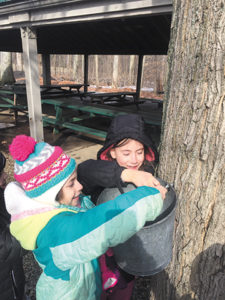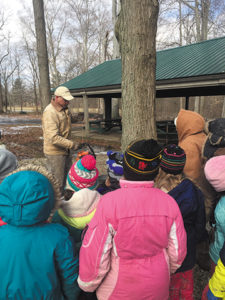 Late winter and early spring is maple season; that time of year when maple producers in Ohio and other parts of northeastern North America tap maple trees to collect sap. This sap is boiled down to produce maple syrup, or further processed into maple sugar, fudge, nougat, cream or other products. Maple syrup production is unique to North America and specifically the area between Minnesota in the west, Kentucky in the south and the eastern Canadian providences in the north. If you have access to a few maple trees, whether growing in your yard or in a woodland, you can produce your own maple syrup and perhaps even have enough to use as gifts for family or friends. It’s easy, great fun and a very educational family activity. Making maple syrup requires boiling the sap until the sugar content of the sap reaches a desired level. While sap can be collected from any maple species, sugar and black maple are preferred since the sugar content of their sap is higher than other maple species. Starting with a higher sugar content sap requires less time and energy to produce a desired product. This doesn’t mean red and silver maples can’t be tapped for syrup. Good syrup can be made from red or silver maple, but it is more likely to be cloudy and the tapping season may be shorter.
Late winter and early spring is maple season; that time of year when maple producers in Ohio and other parts of northeastern North America tap maple trees to collect sap. This sap is boiled down to produce maple syrup, or further processed into maple sugar, fudge, nougat, cream or other products. Maple syrup production is unique to North America and specifically the area between Minnesota in the west, Kentucky in the south and the eastern Canadian providences in the north. If you have access to a few maple trees, whether growing in your yard or in a woodland, you can produce your own maple syrup and perhaps even have enough to use as gifts for family or friends. It’s easy, great fun and a very educational family activity. Making maple syrup requires boiling the sap until the sugar content of the sap reaches a desired level. While sap can be collected from any maple species, sugar and black maple are preferred since the sugar content of their sap is higher than other maple species. Starting with a higher sugar content sap requires less time and energy to produce a desired product. This doesn’t mean red and silver maples can’t be tapped for syrup. Good syrup can be made from red or silver maple, but it is more likely to be cloudy and the tapping season may be shorter. Before you start tapping trees, you need to be sure the tree you want to tap is actually a maple. Many a hobbyist has been frustrated with their sap collection endeavors only to learn they have tapped an oak or hickory.
Once you have explored your yard and identified all the potential trees to tap, the next step is to assemble the equipment that you will need to launch your backyard maple adventure. If you are only tapping a few trees, this is not a big deal and for the most part the equipment you will need is readily available. However, there are a few rules that you need to follow if you are going to be successful in producing a jar of one of nature’s sweetest treasures.
First and foremost, you are producing a food product that you and your family will be eating and enjoying. That means you need to be as careful about producing your syrup. You need to use proper sanitation, process the sap as quickly as possible, and the equipment you use should be food grade. This means your gathering and collection containers are made of material that can be used to store a food product. Also, be aware that maple syrup can absorb the flavor of a container that was used to hold products like pickles and spaghetti sauce. You may already have some of the items needed for this endeavor on hand, or you can buy them at a local store. Others—such as metal and plastic collecting spouts (called spiles), a hydrometer, collecting buckets or bags and finishing filters—are unique to maple production.
 When to Tap?
When to Tap? Sap flow occurs during the dormant season (leaves off), when nighttime temperatures are below freezing and are followed by days when there is a rapid warming above freezing (ideally to about 40 degrees Fahrenheit). The sap with higher sugar content usually occurs in the spring and therefore most tapping is done in late winter to early spring. Some producers tap by the calendar, routinely tapping each year on or before a certain date such as President’s Day. Others watch the weather for predicted suitable conditions. Sap flow from a tapped tree will not occur every day throughout the tapping season, but only when conditions are right. Sap can be collected for syrup production until just before tree buds begin to expand, usually sometime in late March or early April, depending on the weather and location in the state. Sap collected and processed into syrup after bud expansion begins results in “buddy” syrup, which has a distinctly unpleasant flavor described as “bitter butterscotch.”
Cutline to go with pictures:
From Jon and Peggy DeStefano:
Our Ohio granddaughter Nina (seen in the picture to the right, closest to the tree) had an outstanding experience at her school learning how to tap maple trees for syrup. Her teacher Mrs. Oberhaus had this to say:
“We had such a wonderful time today helping Mr. Arnold and many others tap the maple trees. The students were great listeners and helpers! The sap was really running, so most of the children were able to taste it and really see it flowing! I think many of them may be rushing home to ask if they can tap their own maple trees!
In addition, they were able to watch the syrup boiling across the street! I am hoping to collect some sap from my own maple trees so we can also boil in class. The ratio of sap to syrup is about 40 to 1. So, I’m hoping if I can gather about 1 gallon or so of sap, maybe we can end up with a 1/4 to 1/2 cup of syrup!”















Follow Us